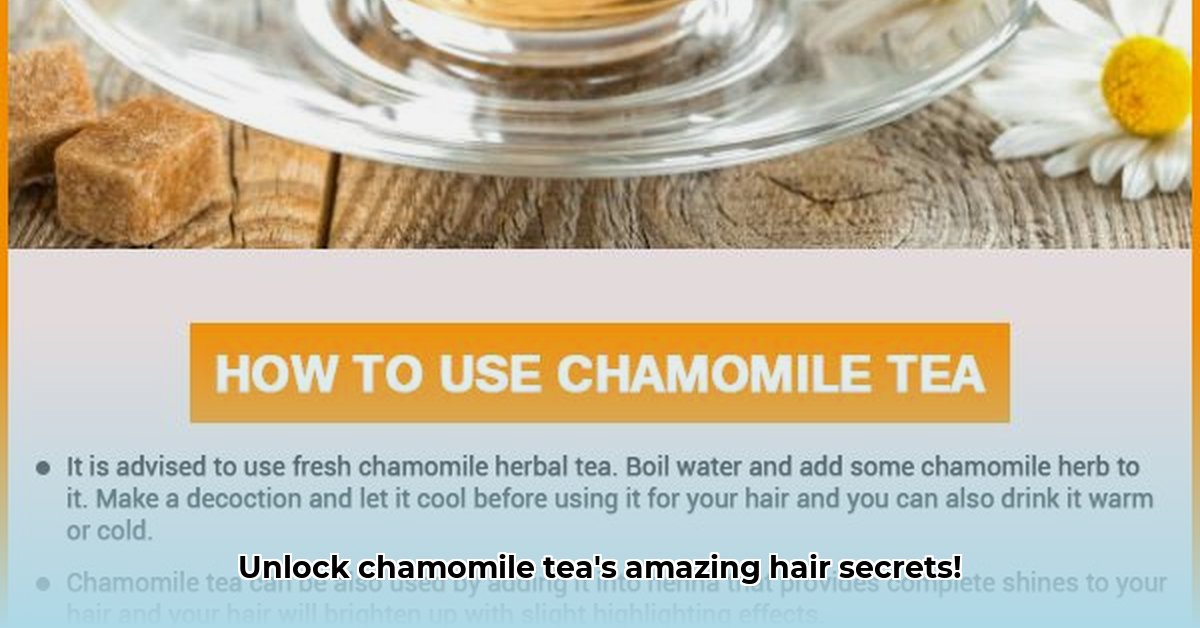
Chamomile tea, beloved for its soothing properties, has also gained popularity as a natural hair care remedy. But does it truly live up to the hype? This comprehensive guide explores the potential benefits of chamomile tea for hair, separating fact from fiction and providing practical, actionable steps for its safe and effective use. While anecdotal evidence abounds, we’ll examine the existing scientific research and highlight areas where further investigation is needed.
How Chamomile Tea Might Benefit Your Hair
Chamomile tea contains bioactive compounds that may contribute to healthier hair and scalp. Primarily, these are antioxidants, which combat free radical damage that can weaken and dull hair, and anti-inflammatory agents, that could potentially soothe an irritated scalp. Think of antioxidants as microscopic bodyguards, protecting your hair from environmental stressors. The anti-inflammatory properties could minimize scalp irritation, creating an environment conducive to healthy hair growth. However, it's crucial to note that while these mechanisms are plausible, robust scientific evidence directly linking chamomile tea to significant hair growth or other dramatic improvements is currently limited. More research is needed to confirm the extent of these effects.
Specific Benefits & Scientific Evidence
Let's delve into specific claims surrounding chamomile tea and hair health. Remember, individual results can vary greatly depending on hair type, texture, and overall health.
1. Hair Growth: Anecdotal evidence suggests chamomile tea might promote hair growth by improving scalp health and potentially reducing inflammation that hinders follicle function. However, rigorous clinical trials are needed to confirm this benefit. More research is necessary to fully understand chamomile's impact on hair follicles and growth cycles.
2. Dandruff Reduction: The anti-inflammatory properties of chamomile may help alleviate dandruff symptoms by calming an irritated scalp. Many report a reduction in scalp itching and flaking, suggesting a potential benefit in managing mild dandruff. However, for severe cases, consulting a dermatologist is essential.
3. Hair Lightening: Chamomile tea is known for its gentle hair-lightening properties, particularly noticeable on light blonde or brown hair. It's often used to subtly brighten hair, creating a natural highlighting effect. However, results are gradual and highly dependent on hair color and the concentration of the tea used. Chemical hair lightening remains a considerably more effective (though potentially harsher) method.
4. Improved Shine and Softness: Many users report increased shine and softness after using chamomile tea rinses or masks. This is possibly due to the tea's moisturizing properties and its potential to smooth the hair cuticle, improving its ability to reflect light.
It is imperative to remember that these benefits are largely based on anecdotal evidence and limited studies. Individual responses will vary significantly.
Your DIY Chamomile Hair Care Guide: Making and Using a Chamomile Tea Rinse
Ready to try chamomile tea for your hair? Follow these detailed instructions for creating and using effective rinses and masks:
1. Brewing the Chamomile Tea:
- Use 2-4 organic chamomile tea bags (or 1-2 tablespoons of loose chamomile flowers) per cup (8 ounces) of freshly boiled water. Organic chamomile ensures that you are using a purer product free from unnecessary chemicals.
- Steep for 15-20 minutes to extract maximum beneficial compounds.
- Allow the tea to cool completely to room temperature before applying it to your hair. Hot tea can irritate your scalp.
2. Application Methods:
- Chamomile Tea Rinse: After shampooing and conditioning, pour the cooled tea over your hair, gently massaging it into your scalp. Let it sit 5-10 minutes before rinsing with cool water. This method is suitable as a regular part of your hair care routine.
- Chamomile Hair Mask: For a more intensive treatment, mix the cooled chamomile tea with a conditioner, honey (for moisture), or aloe vera. Apply to damp hair, leave on for 30 minutes, and rinse thoroughly. This more intense approach is an occasional treatment best done once or twice a week.
3. Frequency and Important Considerations:
- Start Slowly: Begin with once or twice a week, observing your hair and scalp for any reactions or improvements.
- Patch Test: Always perform a patch test 24 hours before widespread use. Apply a small amount to the inside of your arm to check for allergic reactions.
- Sensitive Scalps: Dilute the tea with additional water for sensitive scalps.
Potential Side Effects and Precautions
While generally safe, chamomile can cause allergic reactions—especially in individuals allergic to ragweed or similar plants. Sun sensitivity is another potential side effect; use sunscreen if spending time outdoors after using chamomile tea on your hair. Should you experience any scalp irritation, redness, itching, swelling, or other adverse reactions, discontinue use immediately and consult a dermatologist. If you have existing scalp conditions, a dermatologist's consultation is advisable before incorporating chamomile into your hair care routine.
Conclusion: Realistic Expectations and Future Directions
While chamomile tea shows promise as a complementary natural hair care remedy, it's important to have realistic expectations. The benefits are often gradual and vary considerably among individuals. Its efficacy needs further scientific validation through large-scale clinical trials. Combined with a healthy diet, proper hydration, and a gentle hair care regimen, chamomile tea may offer additional benefits for some individuals. However, it is not a miracle cure-all and should remain a supplementary element of a comprehensive hair care plan. Stay informed on future research into this area for more definitive conclusions on its overall benefits.